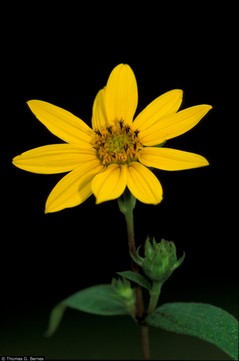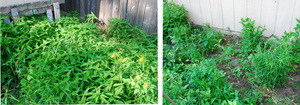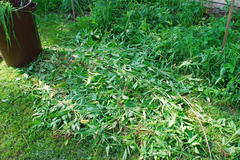A native plant battle: Sometimes one species must go to make room for others to thrive

Woodland Sunflower (Helianthus divaricatus), a worthy competitor
Photo by Thomas Barnes, Thomas G. Barnes @ USDA-NRCS PLANTS Database / Barnes, T.G., and S.W. Francis. 2004. Wildflowers and ferns of Kentucky. University Press of Kentucky.
Let me forewarn you, the forthcoming report from the front is not pretty — not for the squeamish or faint of heart.
There was a major battle in my backyard yesterday, and I have to admit that I was a willing participant. It was mano a mano, sort of, me against a native plant, a worthwhile adversary that had pushed me just a bit too far.
Sometimes, as I’ve mentioned in the past, even a native plant can outstay its welcome or get too big for its own britches. This time, the adversary was not Dutchman’s Breeches, a docile, feathery little guy that goes away in late spring/early summer.
No, this was something far bigger, far more agile and determined: I’m talking, of course, about my backyard nemesis, Woodland Sunflower (Helianthus divaricatus).
First, when preparing to do battle with anyone or anything, you must get to know your enemy, so here it is. Woodland sunflower is actually a great plant, a happy yellow composite flower about 2 ½-3 ½ inches wide that brightens up many a woods edge in late summer-early fall.
Although I haven’t witnessed it myself, I am told that little birds love to eat the seeds of this native sunflower (which is native to most of eastern North America). It may reach heights of two to six feet tall and has a dark green, triangular shaped leaf with a short stem that is rough on top and reaches three to eight inches in length.
The stem is mostly smooth, and I noticed a glaucousness (whitish bloom or coating) near the base of the stalk as I did battle. Here is a website with more information and some great photos: http://www.missouriplants.com/Yellowopp/Helianthus_divaricatus_page.html.
On its own, this is a very nice plant, and if you have room for it to grow and spread, it might be a nice addition to your yard. But, as I’ve said more than once, I don’t have either, and my “prairie” measures approximately one one-thousandth of an acre, so my space is precious.
Also, I am dedicating my wide open space to plants that support butterflies and other pollinators, so I like to encourage the milkweeds, asters, beardtongues and rudbeckias to settle there and make a lot of leaves and flowers. Imagine my horror then, when the peaceful village that is our prairie was overrun by the rogues from the woodlands, the Helianths!

On the left, a pitiful scene of botanical domination, on the right, post battle, the underdogs live to become bug food.
Rick Meader | Contributor
The bucolic countryside, sparsely populated by the docile Asclepias, the unassuming beardtongue kin (hairy and foxglove), the occasionally too tall asters, the rye family, and even the understated prairie dock, were being smothered by hordes of the helianths, spurred on by the damp weather that kept the soil soft, easy pickings for their underground runners.
It was a sorry sight indeed, the little guys struggling for air and sun as the triangular-leaved marauders swept through the little villages, even invading the rootspace of the overtaken bloomers. As I surveyed the scene, it became clear that only one power was more super than the helianths, and that power was me.
I took on the role of NATO and launched an immediate, sustained and back-breaking assault on the enemy, uprooting and occasionally snapping off at the heels hundreds, if not thousands, of their troops. I tell you now, if they were mosquitoes, I would not have lived to tell you this story today.
As I pulled fistfuls of the dagger-leaved raiders, I felt a tinge of remorse. How could something so good be so bad? But then I saw a poor swamp milkweed, and then a wimpering wild bergamot, struggling against the tide, spindly with a lack of sun, and my resolve was strengthened.
Individual pillagers were delicately sniped from within clumps of New England aster and prairie dock, freeing the innocents to seek the sun they so desperately needed. Advance scouts were stopped in their tracks as they started their move across the sunnier regions of the land.
I tried not to look at the carnage I was causing, but eventually, the pile of carcasses was too great to ignore, and I stopped to ponder, was this cause just? Who was I to play God and decide who would live and who would die? But then I remembered the monthly mortgage bill and decided that the right was mine, and I forged on, picking off as many of the remaining fighters as I could find.

Mid-battle, the sunflower carcasses start to pile up.
Rick Meader | Contributor
Is the battle over? Perhaps, but the war rages on, underground, for most of the plants had underground runners seeking new territory to conquer. As I planted new plants to add to the prairie’s diversity, I noticed a veritable underground network of moles (so to speak) just waiting their opportunity to spring forth anew when I’m not looking. The war has not gone chemical yet, but I fear that I must escalate at some point, to track down the subterranean warriors where they live, even if it’s dark and scary down there.
Regrets? I have a few, but then again, too few to mention. If they would just stay where they belong, or just spread a little, I would be happy to have them in my yard, but they have proven to be unruly guests, so I am revoking their invitation, battle by battle. I hope this, and the pictures, were not too much for your stomach to handle.
On the brighter side, I have many more hospitable natives blooming in my yard. Wild ginger, woodland phlox, wild geranium, wild strawberry, barren strawberry, Solomon’s seal, false Solomon’s seal, starry false Solomon’s seal, jack-in-the-pulpit, trillium, graceful sedge, pussytoes, golden Alexander, yellow pimpernel, carrion flower, mayflower, hairy sweet cicely and redbud (just barely) are all brightening our yard, in a calm and civilized manner. Get out and enjoy nature everyone!
Rick is a local landscape architect with a special interest in all things natural, including native plants and the critters that eat them. You can contact him at yourland1824@gmail.com.


Comments
Monica Milla
Tue, Jul 26, 2011 : 12:33 p.m.
Interesting -- I love Helianthus divaricatus. I have a huge area I cleared of buckthorn, and a now a big clump of that is woodland sunflower. I never water it or do anything to it--I can see people with smaller spaces and with money to spend might want to buy specific other plants, but for me I love that it's taking over space that is really hard for anything else to grow in (clay, lots of old roots). I also have goldenrod and native asters in near it, which keep it in check a bit.
EcoRonE
Wed, May 25, 2011 : 12:13 p.m.
At the park I steward in SE AA, the native sunflower can't compete with Canada thistle :-( In my small urban yard, prairie dock is extremely aggressive, attracting large flocks of goldfinches feeding on the seeds (readily spreads by seed). Another overly aggressive native in my yard is spikenard. It has large tuberous roots that spread over a large area and sprout up all over. Moonseed, a native creeper, took a few years to get established, but it too has become very aggressive creeping under the soil and sprouting up all over.
RunsWithScissors
Wed, May 25, 2011 : 1:49 a.m.
Congratulations on surviving the initial level of "Garden of Warcraft"! Next up is a death march with Ajuga Reptans and a fight to the finish with Campsis radicans.
Jackie Byars
Tue, May 24, 2011 : 4:52 p.m.
The tall coreopsis do a remarkable battle with sunflowers in one of my gardens. The big spreader this year is cow parsnip, a truly bizarre (and huge) plant that I love--in its place (as in, just outside my back porch, where I can see its blooms). It produces tons of seeds, and new plants have shown up everywhere, so we dug them out. This year, I have to be sure to cut off the seed heads before they mature.